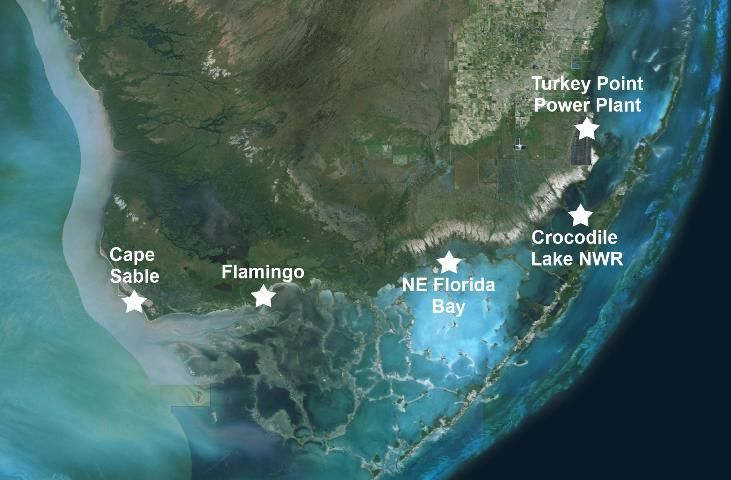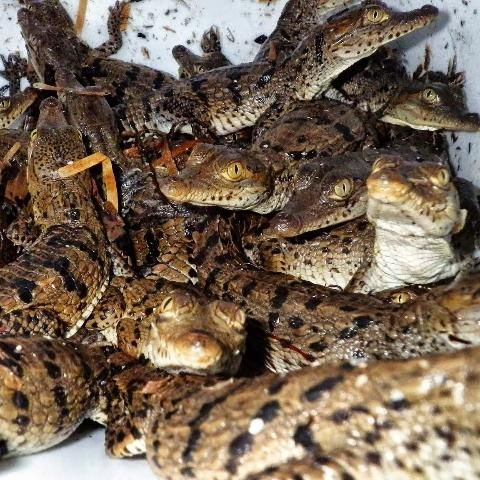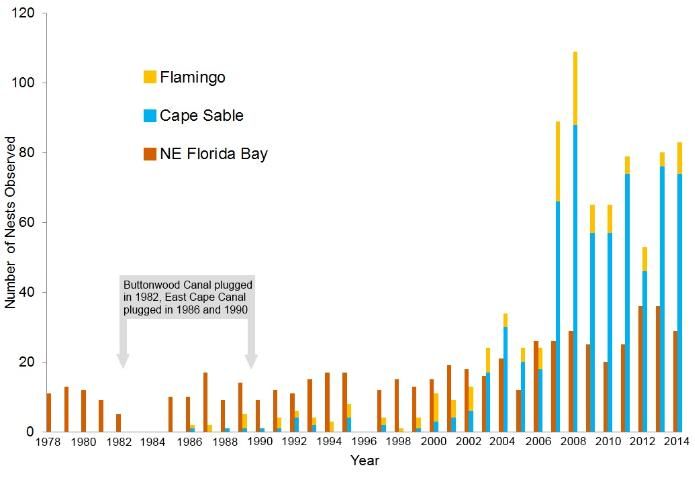The American crocodile (Crocodylus acutus) (Figure 1) is a top predator that lives along the southern tip of peninsular Florida. Crocodiles inhabit saltwater, brackish water, or freshwater near coastal areas in mangrove-lined ponds, creeks, coves, man-made ponds, and canals. In 1975, the American crocodile was federally listed as an endangered species. Conservation and management have helped the south Florida crocodile population rebound, resulting in its downlisting to threatened in 2007. However, habitat modification and decreased freshwater flow to estuaries still present ongoing concerns for this threatened species.

Credit: Jemeema Carrigan, University of Florida
Everglades restoration aims to enhance natural areas and improve abundance and diversity of native species, while also meeting urban and agricultural water needs. Because it is impossible to monitor everything in an ecosystem, a suite of "ecological indicators" is needed to assess restoration effectiveness. Indicators should be representative of the ecosystem, responsive to changes, easily monitored, and understandable to managers and policy makers. The American crocodile is an indicator of ecosystem responses to Everglades restoration because it is sensitive to hydrology, salinity, and system productivity, all factors that are expected to change as a result of restoration.
The American crocodile is a "flagship" species, meaning it represents the ecological importance of freshwater flow into estuaries. Crocodile nesting, growth, distribution, abundance, and survival are linked to hydrologic conditions including rainfall, water level, and salinity. Crocodiles are top predators that affect prey populations of all sizes. Their reproduction, growth, and survival depend on food availability (birds, fish, mammals, etc.), which in turn is dependent on hydrology. Therefore, monitoring changes in the crocodile population allows scientists to assess the health of the entire ecosystem.
Measures used to monitor crocodile populations include relative abundance (animals per km), numbers and locations of nests, nesting success, hatchling survival, and growth. These measures are easy to understand and provide answers to the following questions: How has the number of crocodiles changed? Are they in the places where they should be? Are they reproducing successfully?
The crocodile indicator provides an understanding of the effects of two major ecological stressors in Everglades ecosystems:
- Habitat loss and change (caused by development and water management)
- Altered salinity patterns (caused by diminished freshwater flow to estuaries)
Habitat Loss and Change
Nesting habitat is critical for recovery and persistence of crocodiles in Florida. By the early 1970s, coastal development restricted nesting to a small area of Florida Bay and Key Largo. After crocodiles were declared endangered in 1975, the National Park Service established a sanctuary in northeastern Florida Bay in Everglades National Park (ENP), the US Fish and Wildlife Service established Crocodile Lake National Wildlife Refuge (CLNWR) on North Key Largo, and Florida Power and Light Company developed a crocodile management plan at their Turkey Point Power Plant site (TP; Figure 2).

Credit: UF/IFAS
Today, there are more crocodiles in more places in Florida than there were in 1975. However, nearly all of the increase is due to crocodiles occupying and nesting in human-made habitats, such as canal banks in CLNWR and ENP. These habitats provide nearly ideal nesting conditions: elevated sites that are protected from wind and waves, free from human disturbance, and in close proximity to nursery habitat. However, human-made sites tend to degrade over time, and will need to be actively regenerated to benefit crocodiles in the long term.
Most remaining crocodile habitat is currently protected in public ownership or engaged in support of energy production. Direct loss of habitat in these areas is not a concern. However, upstream development may alter freshwater flow into estuaries inhabited by crocodiles. Regulatory mechanisms are currently insufficient at protecting crocodile habitat from modification.
In addition, an increasing crocodile population means more interactions with humans. Intolerance sometimes leads to crocodile relocation, the ecological impacts of which are unknown. Because human-crocodile interactions are likely to increase in the future, a proactive policy for dealing with problem crocodiles is needed.
Altered Salinity Patterns
Although American crocodiles are more tolerant of saltwater compared to alligators, both species prefer fresh to brackish water. Water management practices have changed natural patterns of freshwater inflow to crocodile habitats in Florida Bay and Biscayne Bay. Lack of freshwater has been correlated with lower growth and survival of crocodiles on a regional scale. In particular, the mangrove back-country of northeastern Florida Bay suffers from diversion of freshwater and has the lowest rates of crocodile growth and survival in Florida.
Young crocodiles are particularly sensitive to high salinity, and they need nursery habitat with low salinity around nesting sites (Figure 3). Hatchling survival decreases with increasing distance that hatchlings have to travel to nursery habitat with suitable salinities. In northeastern Florida Bay, the most successful natural nesting areas are often kilometers away from good nursery habitat. Thus, the combination of saline water and long dispersal distances limits hatchling growth and survival in this location.

Credit: Michiko Squires, University of Florida
Long-term monitoring shows that crocodile nesting responds positively when salinity is lowered in estuaries. In the 1980s, Buttonwood, Homestead, and East Cape canals in Everglades National Park were plugged to reduce saltwater intrusion. This led to a dramatic increase in crocodile nesting effort and success (Figure 4). Scientists believe that Everglades restoration projects, expected to restore freshwater flows to estuaries, will lower salinities and help crocodiles grow and survive.

Credit: UF/IFAS
Conclusion
The American crocodile and its relative the American alligator are the charismatic megafauna of the Everglades. Crocodiles and alligators are sensitive to environmental changes, and they are well-known species that are easy for both decision-makers and the public to understand. These characteristics make the crocodile an important indicator to communicate progress of restoration in Greater Everglades ecosystems. As freshwater flows into south Florida's estuaries and the estuaries are restored to a more natural pattern, we expect to see increases in relative abundance, growth, and survival of hatchlings, and a continued increase in nesting. Despite progress toward recovery, however, Florida's crocodiles are still threatened by habitat modification and human intolerance. Integrating a recovering crocodile population with an ever-increasing use of coastal areas by humans will be the final challenge in the successful recovery of this once critically endangered species.
Further Reading
Mazzotti, F. J., L. A. Brandt, P. Moler, and M. S. Cherkiss. 2007. "The American Crocodile (Crocodylus acutus) in Florida: recommendations for endangered species recovery and ecosystem restoration." Journal of Herpetology 41(1), 122–132.
Mazzotti, F. J., G. R. Best, L. A. Brandt, M. S. Cherkiss, B. M. Jeffery, and K. G. Rice. 2009. "Alligators and crocodiles as indicators for restoration of Everglades ecosystems." Ecological Indicators 9(6), S137–S149.
For more information contact:
Frank J. Mazzotti
University of Florida
Fort Lauderdale Research & Education Center
3205 College Ave., Davie, FL 33314
Email: fjma@ufl.edu
http://crocdoc.ifas.ufl.edu/